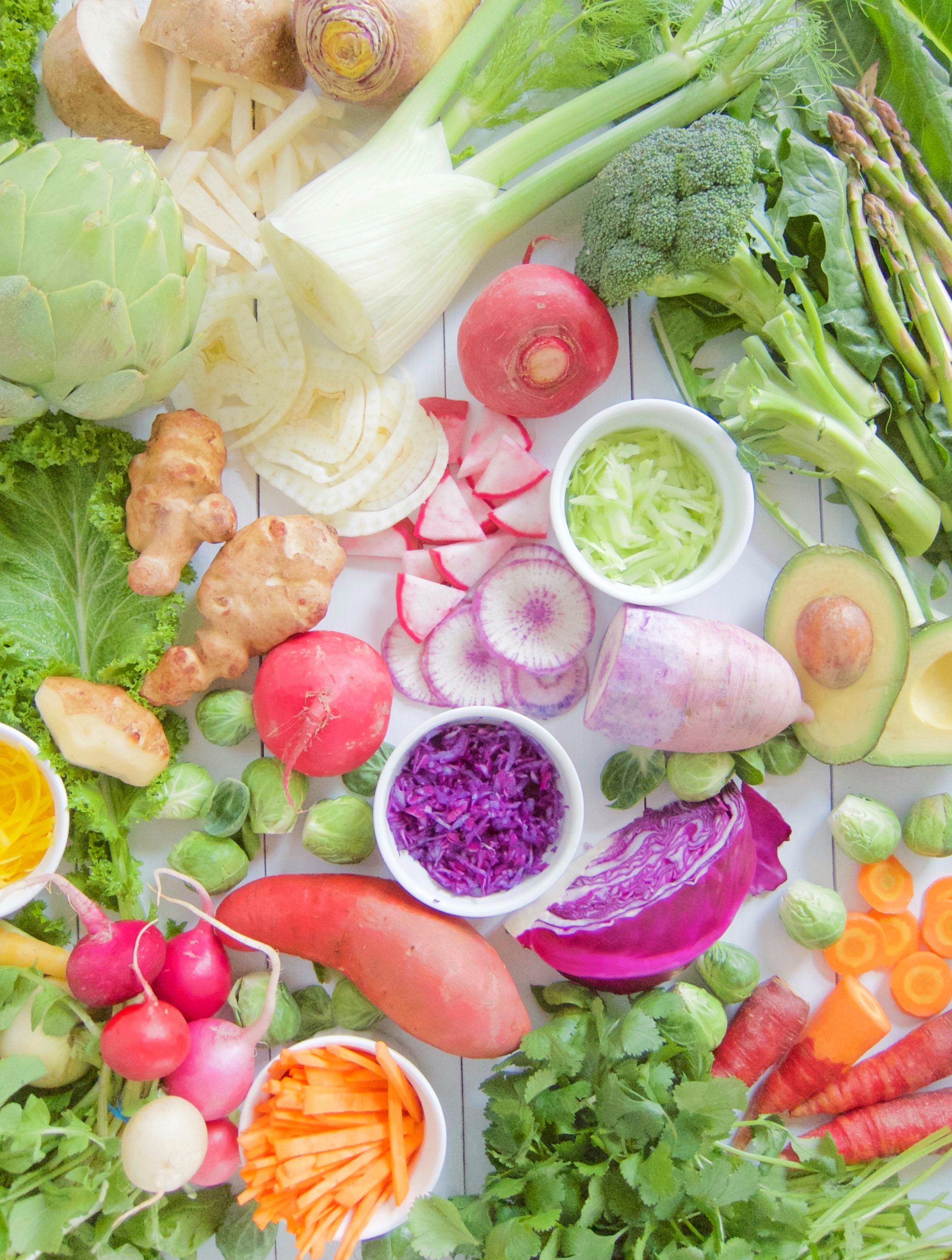Microbiome Rainbow Salads and Smoothies
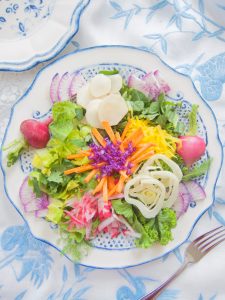
(Pictured: purple daikon radishes, red radishes, sliced fennel bulb, julienned sweet potato, grated rose turnip, grated yellow carrot, grated red cabbage, sliced Jerusalem artichokes, cilantro, romaine lettuce and mustard greens)
“Living inside of your gut are 300 to 500 different kinds of bacteria containing nearly 2 million genes. Paired with other tiny organisms like viruses and fungi, they make what’s known as the microbiota, or the microbiome.”
WebMD
“The microbiome is the center of your health. This has been known for thousands of years by ancient healing traditions that we are just discovering now.”
“We are in the era of the microbiome now and we are really at its infancy even though for functional medicine we’ve been doing this for 30 years, and effectively we didn’t know all of the reasons why everything was working, and now we’re learning and growing about it. It’s just an extraordinary time.”
Mark Hyman, MD, Dir. Cleveland Clinic Center for Functional Medicine
“Could our microbiome hold the key to mitochondrial health and ultimately longevity?”
“The Human Longevity Project”
“What the field of microbiome science has really forced us to do, relatively recently, is to acknowledge that not only are we a system of multiple organs and tissues that work together, but living in us and on us is this incredibly complex eco system of microbes that play a tremendously important role in health and disease by interacting with each other and interacting with us the host.”
Claire Fraser, Phd, Dir. Institute Genome Sciences, Univ. of MD
“We really are in the area of research where the microbiome is really hitting all fields so microbiome health is impacting cardiology, neurology, immunology, endocrinology, that they’re finding your gut microbiome can impact all these different disease processes. Now they’re still trying to figure out how but they do know that the more diverse your gut is that the more protective effects you have through all these different diseases.”
Datis Kharrazian, PhD, DHSc, DC, MS, MMSc, FACN, is a clinical research scientist, academic professor, author and a functional medicine health care provider.
“The bacteria in the microbiome help digest our food, regulate our immune system, protect against other bacteria that cause disease and produce vitamins including B and Vitamins B12, thiamine and riboflavin and Vitamin K, which is needed for blood coagulation.” A break down anywhere in the good bacteria’s role, can lead to sugar and hormone imbalances and deregulation of neurotransmitters which can affect mood, sleep, hunger, energy, etc., malfunctions of the body’s systems, as well as malfunctions and diseases of glands and organs.
“Metagenomics is the DNA study of the various microbes within the gut itself. It’s the same thing they use to try and study and figure out the human genome.” “When we did the Human Genome Project we were trying to figure out exactly what kind of gene controlled all the different disease markers.” “The idea was for every disease there was a gene that controlled it. If we could find that gene, we could somehow manipulate it and somehow change the outcome of the disease.”
“We have 22,000 functional genes. Our microbiome has 3.3 million genes.” “The microbial genes, the genes that come from the bacteria that live in our body account for 99% of our metabolic function.” “Everything that is happening in your body right now, 1% was coded for the genes you have in your cells. 99% of it was coded for the bacteria that live in your body. That’s how much control they have over us.” “So it becomes exceedingly important to understand who they are, what they are doing and how we can influence them.” The human genome project was about linking our DNA to diseases and seeing how it could be manipulated to avoid the disease. Now the race is on to connect the DNA of our microbes to which disease and then build up those microbes.
Dr. Kiran Krishnan, microbiologist and Co-founder of Microbiome Labs
‘The microbiome is cohabiting our body with us. In the past most immunity research focused on the white blood cells and antibodies and while these are important, we need to rethink what it means to be human. The understanding of the microbiome is going to overturn everything we think we know about health, about nutrition and medicine. The previous thousands of scientific papers are invalidated because the microbiome was invisible to them. We have far more cells that are fungal and bacterial than human. We humans need to go from feeding one to feeding trillions to boost our immune systems and overall health.’
“Remedy: Ancient Medicine for Modern Illness”
“‘Name just about any ailment plaguing us and you’ll find some researchers discovering the microbial angle for a connection,’ says {Scientist Jeff} Leach {of The Human Food Project}, whose latest book, Bloom: Reconnecting with Your Primal Gut in a Modern World, is due out this fall {Sept. 2013}. Recent studies have implicated gut microbes in everything from autism and depression to cancer and diabetes to heart disease and obesity. ‘It’s a watershed moment for human health,’ says Leach.”
“‘Become a little more adventurous in the produce section. This is a part of your health you can control. You can shift your microbiome.’”
eating well.com
There are protective, fortifying lifestyle changes we can make that create an environment in our microbiome and bodies that is inhospitable and uninhabitable to pathogenic invaders and even to the formation of cancer cells.
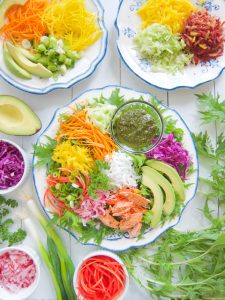
(Pictured: mizuna [beautiful Asian greens also called ‘Japanese mustard greens’], green leaf lettuce, julienned sweet potato and multi carrots, grated multi carrots, grated broccoli stem, grated radishes, sliced red cabbage, sliced green onions, parsley, avocado, pesto, herbed salmon, and cold white Basmati rice)
A New Paradigm:
A New Medicine and a New Diet
Most of us lay people who have been taking probiotics after antibiotics without really knowing why, other than the basic understanding that along with the killing the pathogens antibiotics kill good bacteria and other friendly microbes. It’s also basic knowledge that fiber is good for you. Most people know fiber keeps your body regular. But few people are aware of the much more significant role fiber plays in the body. Fiber is food, a ‘prebiotic,’ for the microbes in our gut. And it’s not just after antibiotics that we need to be replenishing the good bacteria and feeding them a lot of fiber. We’ve arrived at a place where we’ve become aware that our diet and environment have done our microbiomes that play more of a role in our health than we ever imagined.
Whether you are feeling it yet or not, people eating a normal diet are aging and on the path to imbalance of the microbes, resulting in a dysfunction of the body eventually leading to disease. Everyone, children included, all are in need of repairing, rebalancing and strengthening the microbial powerhouse that is playing big role in your health and happiness. Our toxic environment and stressful lives need to be addressed. But the biggest help we can give our microbiome is done primarily through diet. What you eat is what the microbes are eating. And the kinds of foods you eat can be building up the good microbes and starving the bad microbes or the reverse, or somewhere in between.
Normally the microbiome is able to police the microbes and keep itself balanced. But the changes in recent decades to our diet, medicine and lifestyle, along with the modern day environmental toxins, turned out to be beyond the microbiome’s ability to care for itself and us. This battle going on that was unknown to us resulted in more disease and the new autoimmune diseases and an epidemic of obesity, more every year and at younger ages. The number of diseases are exploding like nothing doctors have ever seen before in all of history. Our genes haven’t changed. But our environment, which includes our food, has changed. Research into this health crisis lead to the discovery of the microbiome, and as more doctors became aware of the research a new kind of medical field emerged called ‘functional medicine’ which has caught the attention of both conventional medical doctors and holistic doctors.
What was found was that stress, our greasy, mostly processed food diet, overuse of antibiotics, polluted water and air, and our over sterilized and sanitized lifestyle, to name a few things, have ravaged the microbiome and left it with not enough of the different good microbes and an overgrowth of problematic microbes. This state of ‘dysbiosis’ means a weakened microbiome that has lost its ability to control the right balance of microbes and it’s now malfunctioning. The first line of immune defense is down allowing invaders – undigested food particles, toxins and bugs – into our body through inflamed, “leaky” intestine walls to wreak havoc all the way up to our brains. There are many books and articles now showing how the application of the new protocols to address the microbiome imbalances is already reversing very complex health crises many people have found themselves in.
Both the microbiome and the body will self-repair if properly supported. Mindfully replenishing the diminished microbes by feeding them prebiotic foods, botanicals, taking probiotics, body chemistry, and the nutrients that the microbe isn’t making enough of until it can again, fasting, exercising, and, while the gut is healing, avoiding what you know to be inflammatory foods for you — all these will support the weakened and overwhelmed microbiome as it rebuilds and rebalances enabling the microbes to once again police the bad microbe issues, keep out of the body what doesn’t belong, and fix malfunctions in the gut that lead to malfunctions in the rest of the body.
Making the change to your diet to feed the microbiome begins with a better understanding of plant fiber and soil. After fiber-rich foods are digested, the fiber will have passed through the stomach and small intestine not fully digested and absorbed. It then moves into the large intestine, headquarters for all the microbial activity going on all over our body, and where most of the microbiota are. Here the fiber becomes a prebiotic. It ferments and feeds this micro life, building up the normal bacteria that is powering the first line of defense of your immune system which is in your gut, as well as your body, and all the chemical reactions, and metabolic cycles and processes taking place in your gut and in your body supplying what is needed everywhere. In addition to being food for microbes, the breaking down and fermenting of fiber releases short-chained fatty acids needed in the mitochondrial metabolic process of creating energy. Mitochondria are the energy producing organelles in the cells of our body. Without this energy, that all the organelles of cells require to do their jobs, there is cell dysfunction and cell death which leads to a malfunction in the body.
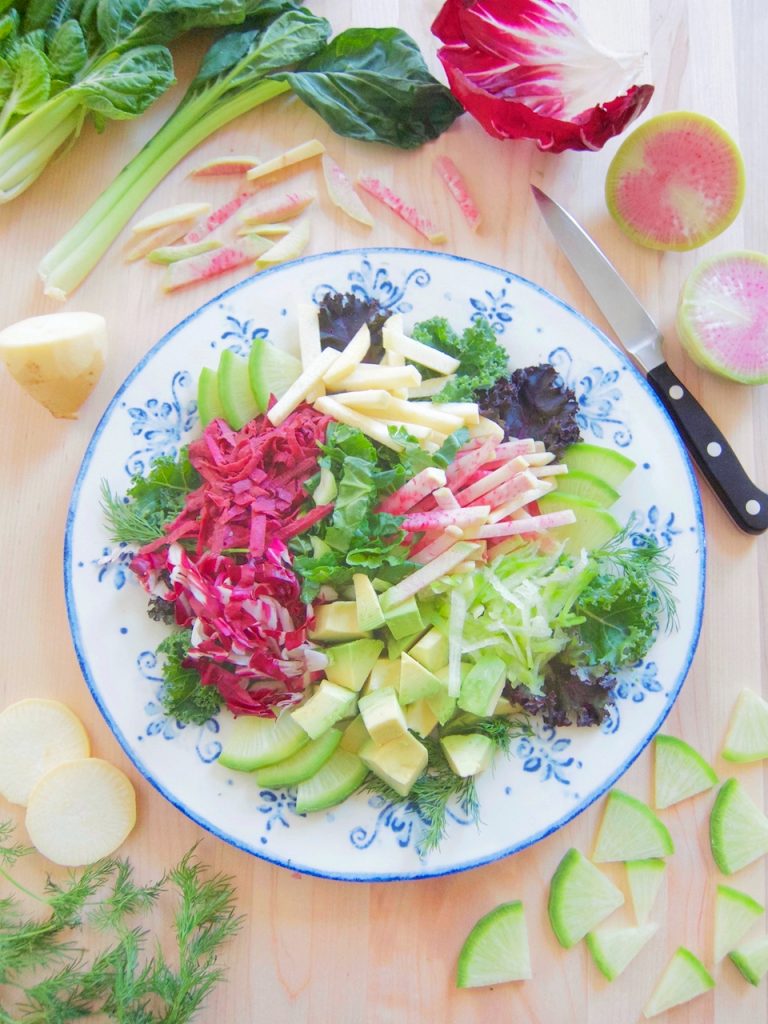
(Pictured: tatsoi, gold ball turnip, radicchio, green daikon radish, grated purple stoke sweet potato, kale, watermelon radish, and fennel fronds)
The building up of the different kinds of microbes begins in the womb and then there’s a huge influx the day you are born. As you leave the womb, you pick up a large part of the bacteria you need from your mother’s body. Then right away you begin to be exposed to toxins, pathogens, viruses, fungi, yeast, opportunistic bacteria, potential auto-immune triggers, and in many cases parasites get picked up somewhere. The exposure to bacteria programs your immune system. It learns, and matures and develops through the exposure process and remains strong the same way. As a child grows up the microbiome builds up what needs to deal with the environment and deal with all these different things that come into the gut and make their home in the microbiome, many with the potential to cause problems if they get overgrown. It learned to police these microbes, and keep low in number what we thought were bad microbes but that turned out to play a positive role in the microbiome. So sanitizing everything turned out to be the wrong thing to do.
In his book Gut Balance Revolution Dr. Gerald Mullin states, “Research has shown that children raised in rural environment, where playing in the dirt and being around farm animals are more common. Have lower incidences of allergies and other autoimmune conditions.” In quoting from Dr. Daphne Miller’s book Farmacology he says, “One of the recurring theses in the book is that the microbial biodiversity of the soil breeds the diversity of our gut microbiome and impacts our health in a variety of ways.” He also mentions that the exposure to other children is exposure to more microbes. Today there is a rise in childhood health issues — weight gain, diabetes, cancer.
You may not have been living close to the dirt where the good bacteria are, and where your microbiome is built up faster as dirt blew into your nose and hitched a ride on your hands into your mouth giving you a good start in life, but we can have that benefit from dirt now without having to live with dirt. Teams of researchers, microbiologists and biochemists have been making probiotics using the most beneficial probiotic strains in soil. They found that spore-forming microbes will survive the trip to through the digestive system to the colon where they will colonize. ‘Soil-based’ probiotics are a mixture of spore-forming and normal. ‘Spore-based’ probiotics, like MegaSporeBiotic, developed by Microbiome Labs, founded by microbiology researcher Dr. Kiran Krishnan and Dr. Tom Bayne, a functional medicine doctor, are all spores. The spores in MegaSporeBiotic do more than ‘reseed’ with good microbes, they “recondition” the microbiome. Dr. Krishnan explains this in “How to Improve Gut Health and the Microbiome”, an interview with author Leah Segetie. These spore microbes recondition by coming into the gut and accessing the condition of the microbiota, and, among a number of things they do, they will stand next to bad or overgrown microbes and make antibodies to lower the population of these microbes, or stand near good ones that are too low and make prebiotics for them to raise their numbers. They will also remove microbes that are in the wrong place in the gut. Using these spores to treat digestive disorders is not new. Doctor’s in many countries have been using it since the 50’s. Microbiome Labs is doing many studies and trials and perfecting its use.
We are intimately connected to earth. Simply put, from photosynthesis with the power of the sun, plants turn photons into sugar or carbohydrates for the microbes in the soil around plants’ roots. Then the microbes give the plants what they need to grow and be healthy. Then we feed the plants to our microbiome which supplies the various microbes what they need to be healthy and function properly. Then the microbiota digest the food and send into our body what it needs to function and be healthy.
Being outdoors in the dirt and around animals is more than getting more different kinds of microbes for a more diverse microbiome, it’s also coming in contact with ‘bad’ microbes, even deadly ones, that play a role in strengthening the immune system. The way our defenses build up so our immune system can handle a strong exposure to an invader is by making anti-bodies, an army of them, as a result of having been exposed to an array of small amounts of harmful microbes in the environment. One group of doctors and researchers are addressing the problem of missing out on good microbes in dirt and another group of medical professionals and researchers, herbalists, have know for 1000’s of years that, among other things that grow in nature, eating mushrooms (fungi), like reishe and chaga, fortify the immune system enabling it to keep bad microbes in check so they don’t cause an illness or other inflammatory response. There are around 6000 recorded botanicals for human health. These plants and/or fungi are can be taken for two different health goals. You can take some to address an illness, or particular health condition or symptom. And the much broader use for them, and what they have been used for historically for thousands of years, is to prevent illness and aging. You can make these powerful botanicals part of your microbiome-centered diet, increasing the variety and potency of the foods you are eating on a regular basis, resulting in a stronger microbiome and staying healthy and living longer. If you want to have a very good understanding of these botanicals, I recommend the excellent 9 part series, “Remedy: Ancient Medicine for Modern Illness”. Plants of all kinds, growing in different places all over the world, are vital for us to heal and maintain healthy microbiomes and bodies. There is a medicinal component, limited but there, in all the vegetables and greens we eat. And there are other much more powerful plants, very special plants, that, when you have a serious debilitating health condition, can play a key role in helping you get your life back and keeping it that way.
Dr. Garland Glenn, a functional medicine doctor and owner of The Carroll Institute, quoting another doctor said to me, ‘After antibiotics, take probiotics but also go to the grocery store and buy every kind of organic foods you see, including the ones where you don’t know what they are, and go home and make a smoothie out of them using a machine that doesn’t remove the fiber, and drink this twice a day,’ and he added ‘especially roots [and tubers].’ A Nutrabullet works great for the smoothies. You can do a smoothie for breakfast and I decided to have the second batch of raw vegetables as a large salad. Make both out of of all different kinds of plants and vegetables that are new to you, and use vegetables raw that you’d previously only eaten cooked. A selection of blended vegetables can end up undrinkable but those same vegetables are fine for a salad. I have made some suggestions below under the picture of a smoothie. (Please make a note of the list of foods at the end of this post that should not be eaten raw).
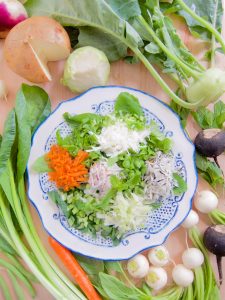
“…But rather than chewing a carrot, better to spread it and put it in your salad because you’re massively increasing the surface area and your ability to absorb the nutrients and fiber.” Dr. Mercola
(Pictured: sliced green beens, grated purple top turnip, grated jicama, grated green kohlrabi, grated black radish, and grated orange carrots on sliced komatsuna greens or ‘Japanese mustard spinach’ with stems and sliced Japanese Hakurei turnip greens and stems, and mint)
Hunter-gatherer peoples, hunting animals and gathering nuts, berries and tubers, are doing two things well. They are exposed to more probiotic spores from dirt coming in, and then they build those up with their very diversified, high fiber diet, which is also feeding the normal, non-spore, microbes in their gut. And, I should add that they aren’t eating soaked or triple washed vegetables where there is only a small possibility that any microbes remain on the outer skin. Dr. Weil’s article, “Diet for a Better Microbiome”, reports some studies done on hunter-gatherer peoples in the world where something interesting has been learned about the microbiome. These people eat a lot more fiber and 600 different kinds of foods, meals made of small amounts of a lot of things, compared to Americans’ (typical) 15 different kinds, meals with large portions of a few foods. These ancient people were also tested and were found to have less diversity during certain seasons, and then the return of the diversity in other seasons. There was a follow up study done on mice where it was taken away and then returned with the same results.
It’s speculated that we have a huge variety of microbes and it’s when we eat the food they need that they grow in number and are able to play their role in protecting and strengthening us. Dr. Mick Hall, a biorestorologist and owner of 35 for Life, expressed his opinion this way. He believes “we all have a near unlimited number of species of organisms within the intestinal tract, but according to gut health, most are suppressed until properly supported to reproduce.” And another doctor put it this way, “If you don’t eat the preferred fuel of the species of microbe, that microbe will decrease until it’s fed again.”
You can be “rich” in microbes, meaning a lot of different kinds of microbes, but if they are low in number, the diversity is not there. They need to be rich and there needs to be “uniformity” in order for there to be diversity. In an interview with Dr. Joline Brighten, microbiologist researcher Dr. Krishnan explained that “The microbes have different capabilities of their own, meaning they each produce different kinds of enzymes.” “So they specialize in breaking down different types of carbon molecules…simplistic carbohydrate structures or complex carbohydrate structures.” “They need a variety of carbon sources.” “And it’s counterintuitive but other microbes do well when you are fasting on a regular basis.”
Being on a Paleo or Keto diet is beneficial in the short term but it’s not the ideal long term diet. So once you have lost the weight you wanted to lose, and your leaky gut has healed, along with all the other benefits, it’s time to stop being in ketosis. Every form of fasting is beneficial but they are not the end of finding the perfect diet that you then follow for the rest of your life. Dr. Gundry has said that you can overdo eating nutrients. He has also done numerous videos on specific foods showing that virtually all foods can be problematic for certain people. A 30 day or preferably much longer reset diet will help you locate what your body is sensitive too and you stop eating those. Then you need to eat individual foods in moderation so you aren’t getting too much of a particular nutrient, and also not overeat putting a strain on your digestive system and gain weight.
Dr. Datis Karharrazian says that your body’s self-repair pathways are activated when you take the next step after being on a paleo or keto diet and you begin to do intermittent fasting starting with eating for 10 hours and fasting for 14 hours and building up to an 8 hour window of eating and 16 hours of fasting. He says during the first 12 hours of fasting the body depletes glycogen that is stored in muscles and the liver and then moves into a ketogenic or fasting state. Then in this state some very interesting things happen. In addition to losing weight without losing muscle, the ketones that are made become a very efficient fuel source for the brain and there is much improved brain endurance and cognitive function. Ketones also have an anti-inflammatory effect reducing inflammation. Ketones also turn on pathways like brain derived neurotropic factor that improves brain synapsis and connection. There’s also a metabolic switching that takes place involving recovery that can be critical for athletes, people with leaky gut, rheumatoid arthritis or a traumatic brain injury. Ketones also active an antioxidant producing pathway that protects against free radicals, toxicants and pollutants, and a pathway that slows down the build up of protein plaque that can lead to brain dysfunction like Alzheimer’s and Parkinson’s. In cancer research, when animals are in a ketogenic state it disrupts fuel reaching cancer cells so there’s potential for intermittent fasting benefitting cancer patients. “Getting into a fasting state also turns on metabolic switches, especially the NRF2 pathway which turns on things like glutathione which has anti-inflammatory pathways. So it really turns on what your body needs to recover, and to repair and to regenerate and slows down the neurodegenerative process. That’s why intermittent fasting is so critical.”
When you aren’t feeding your microbiome for 14 to 16 hours the numbers of microbes that only do well when you are fasting will increase helping you create both richness and uniformity, and because it’s not having to digest food all the time, it has time to take out the trash and do repairs. Polyphenols, found in foods like dark chocolate, blueberries and flaxseed meal, aid in the rebuilding of the mucosal layer of the intestinal wall. Dr. Krishnan discusses what to avoid, including explaining what stress does, and lists all the good things to be doing for the microbiome, along with the building up of microbes and the rebuilding of the gut lining that happens during intermittent fasting in the interview with Leah Segedie.
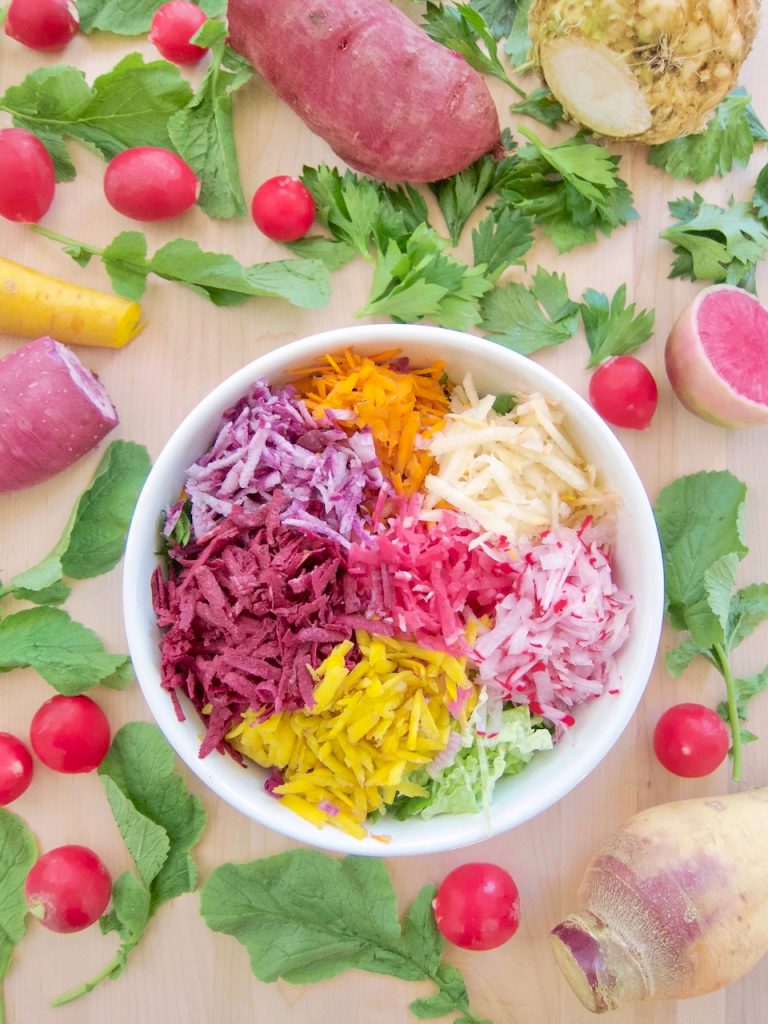
(Pictured: grated red radishes, purple daikon, watermelon radish, routabaga, purple stoke yam, yellow and orange carrots on a bed of micro greens, kale, savoy cabbage, red cabbage, radish greens and celery root greens.)
Green bananas, mangos and papayas, and both cooked, chilled or reheated if you want it hot, white potatoes and cooked, chilled or reheated if you want it hot, white rice are examples of another microbe loving carbon food. “Resistant starch is not exactly a fiber, but another form of carbohydrate [long form of glucose molecules really] that functions like soluble and fermentable fiber. Like fiber, resistant starch is not fully broken down and absorbed in your small intestine and gut bacteria thrive on it. When fermented, resistant starch produces short-chain fatty acids as well as gases [which in turn can lead to bloating and abdominal discomfort when eaten/taken in excess].”
InBodyusa.com


(Pictured: cold potato salad made with 5 to 6 cups cubed cooked potatoes (you can use peeled russets or unpeeled Yukon or red potatoes which are waxy potatoes that will hold their shape better than russets), 2 tablespoons each thinly sliced basil, dill, parsley, 1 tablespoon thinly sliced chives, 1 stalk of celery, chopped, 3 tablespoons chopped shallots, 1/2 cup olive oil or part mayonnaise, 1/2 teaspoon each marjoram and salt, topped with sliced and chopped radishes.)
“A full system reset is a great way to establish your baseline so that you can begin to identify your own optimum dietary habits.”
Dr. Kelly Brogan
When you’ve been on a restricted anti-inflammatory diet you are doing a system reset. For a specified time it’s very strict and then foods are reintroduced and you watch for sensitivities. If you have become very sensitive, it can take awhile to figure out all the foods that are inflaming your gut and keeping it from being able to heal. The reset is a critical step towards healing the gut. Something happens as a result of the restrictions where you are better able to listen to your gut, a clearer communication that enables you to figure out your diet that will lead to long term healthy changes. And your taste buds change and what you enjoy eating changes and it’s the communication with the healing microbiome that is involved in this.
(Note: And not all food sensitivities are related to a leaky gut.)
On the restriction, or anti-inflammatory, diets, all grains and sugars (carbs), including sugary fruits like watermelon and grapes, are eliminated. These are high glycemic foods that digest quickly and spike blood sugar giving you a lot of energy but then the blood sugar drops. On these no sugar/glucose diets, a switch takes place where the body and brain are being powered by fat instead of carbs, referred to as a ketogenic diet. A ketogenic diet is a therapeutic diet that should only be done for the amount of time needed to reach a health goal like the system reset. You start off strict but then you need to move to a mild ketogenic diet because the body and brain need insulin. Eating foods with sugar/glucose cause the release of insulin which, among other metabolic roles it plays, is needed to make protein. If you remain on a strict ketonic diet too long, you can begin to lose muscle mass and your body can be in an almost cachectic state where it begins to waste away. To eat right long term, one answer to the body’s need for sugar/glucose is resistant starches. And even though they digest slower, it’s still necessary to eat the right amounts to maintain blood sugar balance, the sweet spot, not too much and not too little.
“Lack of glucose (sugar) is … a common cause of poor brain function… Low blood sugar (hypoglycemia) and high blood sugar (insulin resistance) both deprive the brain of energy and inflame it.”
Datis Kharrazian, PhD, DHSc, DC, MS, MMSc, FACN
(Note: High blood sugar (insulin resistance) is not just the result of our diet. It can be caused by not enough, or the lack of, exercise.)
“Consistent consumption of resistant starches attenuate cravings, up regulate satiety signalling, and help you to stop feeling crazy, especially when you are following a ketogenic diet.”
Dr. Stephanie Estima
Resistant starches are resisting or taking longer to be broken down and this helps stabilized blood sugar levels so you aren’t dealing with feeling energetic and then falling into fatigue, an imbalance of insulin secretion. Resistant starches improve leptin (another hormone) sensitivity so you feel full when you should, help sleep by enhancing non-REM sleep, curb cravings (the feeling like you’re starving that no amount of fats or proteins or vegetables can alleviate), better mood and cognitive function because they effect the microbiome’s production of neurotransmitters, and when resistant starches undergo fermentation the microbiota produce butyrate, a short chain fatty acid that has protective effect in colon cancer and improves T cells, cells that play a vital role in our immune system. When you’re dealing with diabetes and weight issues, there’s malfunction involving the regulation of both hormones, insulin and leptin.
A mild ketosis diet is not only good for your insulin and leptin levels, it raises the protein BDNF (brain-derived neurotrophic factor) involved cell regeneration and stem cell growth in the brain for diseases like Alzheimer’s. BDNF changes the levels of a protein called PGC-1Alpha which plays a role in mitochondrial therapy and regeneration. PGC-1Alpha is also intimately involved in obesity and diabetics and other disorders. The metabolic process of burning fat for fuel generates less free radicals and less inflammation both of which underpin all disease. One of the ketones produced on by burning fat is called beta hydroxy butyrate. This ketone isn’t just energy for the body. It also stimulates changes in our DNA expression (more on this below). More and more it’s being found how a mild ketonic diet changes our metabolism dramatically for the good.
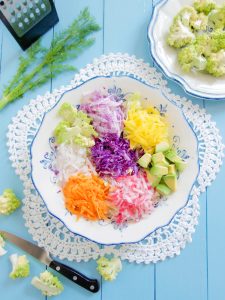
(The grated vegetables this picture is scarlet turnip, white and purple daikon radishes, orange jewel sweet potato, red cabbage, yellow carrot. They are mixed with sliced, sliced romanesque, and avocado. Serve these on napa cabbage and butter lettuce.)
Over the years we have been making changes to our diet but now that we know about the microbiome, the huge role it plays, how we damaged it and how it’s repaired, all these things we were already doing are being brought together, making a clearer sense of everything. These changes included exercising and cutting down on carbs from grains and sugars. Among a number of bad things sugar does to the body, it feeds bad microbes and causes some microbes like Candida to get overgrown and become a problem.
The kind of meat you eat also effects the microbiome dramatically. Eating commercially raised meat and dairy is ingesting low doses of antibiotics and over time they create bugs that are very difficult to get rid of. The animals are caged and in close quarters and it’s caused more disease to arise so antibiotics have been put in their food. Animals are being fed grains that are not organically grown. What cows, sheep, and chickens eat, we eat and it effects our microbiome’s immune function. Look for meats and dairy that say no antibiotics, grass fed, pasture raised coming from animals that are raised in healthier conditions.
We’ve learned to eat rainbow colors of fruits and vegetables that are high in phytochemicals which includes antioxidants to reverse environmental toxins’ oxidizing effect on cells that leads to cancer. I was only seeing the phytochemical value of colored vegetables and didn’t know about the value of light colored vegetables, like turnips or fennel, or the white parts of vegetables like large bok choy, so I didn’t buy the lighter ones while treating the stems and ribs of vegetables as scrapes and throwing them away. The colorful foods have important phytochemicals but now we have a more comprehensive view of our very sophisticated immune system that is more inclusive of vegetables and the invaluable role they play in our health. A microbiologist in the Interconnected series made the comment that phytochemicals are prebiotics for good bacteria and he believes that further research will show that phytochemicals are more important to the health of the microbiome than they are to us.
We are living in an ultra toxic environment and we’re contributing to the damage it does to our bodies with the toxic foods we’re eating. Wheat crops in particular are treated with a poison that triggers zonulin in the gut which leads to inflammation if the intestinal lining opening the junctures letting the things that don’t belong in the body into the blood stream. The inflammation of the cells of our intestinal lining are due to the weakening of the microbiome’s defense system by too many toxins and the impossibility of being able to handle it, leading to a more serious cascade of inflammation inside our bodies called ‘metabolic LPS endotoxemia.’ LPS is in certain bacteria and when they die it is left behind as an endotoxin. When we eat there is more bacteria turnover and the dead bacteria give off LPS endotoxins. A healthy microbiome gets rid of these. But a weakened microbiome means inflamed intestinal walls with its tight junctures separating letting the LPS endotoxins into the bloodstream of the body. From there the molecular inflammatory cascade begins, what Dr. Krishnan says is “a mini sepsis.” Sepsis is lethal, so it follows that chronic ‘mini sepsis’ is going to have the devastating effects on the body that we are now experiencing. This is also discussed in Dr. Krishnan’s interviews.
Undigested proteins also get through the open junctures and this is what can lead to autoimmune diseases where the immune system that has now created an antibody for the food protein mistakenly identifies part of our body, like the thyroid, as that protein invader because the molecular structure of the thyroid is similar.
Lectins are a common food that people have become sensitive to, leading to inflammation in different parts of the body manifested in all different ways big and small. Lectins were brought to my attention by talk given by Dr. Hall many years ago and then another doctor told me about Dr. Steven Gundry’s The Plant Paradox. Lectins are a plant’s way of protecting itself. It’s its natural defense system against foreign threats to its survival. Lectins are primarily found in the seeds of both organic and nonorganic vegetables and fruits. When you eat the plant and the lectins go into your body, they kill good bacteria and can greatly effect your microbiome. To support microbiome recovery avoid fruits like pomegranates and kiwi and vegetables like cucumbers and tomatoes that contain a lot of seeds. Nightshades are part of this group and the reason why some people are sensitive to them and experience the symptoms of inflammation.
Other lectin carrying foods to consider avoiding for awhile are beans, peanuts and cashews, and seeds, like pumpkin, sunflower or chia.
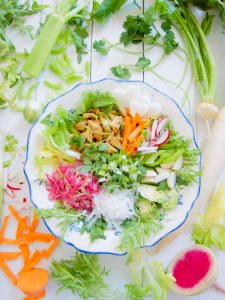
(When planning your meals, you need to eat a lot of vegetables, but think small amounts of a lot of different kinds of things. This salad is made with white daikon radishes, celery, Hakurei turnips, grated watermelon radishes, julienned sweet potato, sliced Brussels sprouts and Shawarma Seasoned Chicken and cilantro on a bed of arugula, escarole and endive frisee.)

(This is a salad served with meatballs made with cauliflower rice in place of bread.)
Similar to a lactose intolerance, some people have difficulty digesting, and have a immune response to, fructans, a ‘polymer’ or grouping of fructose molecules. If you been wondering why you don’t feel great after eating cooked and/or raw onions, you may be sensitive to the fructans in onions. Fructans occur in agave, wheat, rye, kamut, spelt, barley, grapefruit, nectarine, plums, persimmon, pomegranate, ripe bananas, watermelon, dates, raisins, prunes, dried pineapple, onions, leeks, shallots, garlic, jicama, snow peas, savoy cabbage, chick peas, cabbage, broccoli, pistachios, artichoke, chicory root, globe and Jerusalem artichokes, Brussels sprouts, beets and asparagus. If you have noticed that you are not feeling well after eating one of these, remove it from your diet and try again later after you’ve healed some more.
In his talks and interviews, Dr. Krishnan not only lists the things we need to be doing, but he speaks in an understandable language, and using diagrams, describes what is happening at a molecular level that is the reason why we need to make the list of changes. You may have already switched from oils like canola and soybean to healthier oils like olive and avocado, and walnuts, macadamia nuts, avocados, pecans, brazil nuts and pine nuts. Dr. Krishnan explains that bacteria make LPS from the oils we eat. Going further into studying the cascade of inflammation that starts with LPS endotoxins, the toxins in LPS molecules are in their tail and they vary in strength. LPS made from saturated oils produces a more toxic tail. LPS made from the good oils have a less toxic tail. Of the healthier oils, LPS made from coconut oil is the most toxic and omega oils make much less toxic LPS. So when the microbiome is weak, not keeping the barrier strong and not properly disposing of the LPS released as bacteria dies, all oils, especially when heated, including toasted nuts and cooked fatty meats, cause some degree of inflammation of the intestinal lining causing its junctures to open, letting in LPS endotoxins that triggers the “mini sepsis’ inflammatory cascade inside the body.
‘Leaky gut’ lining, also called intentional permeability, allowing things into our blood that are going to cause an inflammatory response, is not just caused by environmental toxins, our diets, or the balance of our microbiome. Dr. Datis Kharrazian has found that in a majority of his leaky gut cases there has been an underlying cause coming from the inside of the body like hormone deficiency, a chronic inflammatory disease, chronic pre-diabetes, or an auto-immune disease. And supporting the microbiome lessens the severity of those health conditions, and also their inflammatory effect on the gut lining causing the junctures to open. See Dr. Kharrazian’s video on the “More to Leaky Gut Than You Think”, myths of leaky gut, on his website.
We’ve always been told to exercise as part of a healthy lifestyle for numerous reasons including keeping our hearts strong. Exercising also plays a role in rebuilding the microbiome and returning it to full function. All of our muscles atrophy as we age and the fluids in them become stagnant. Recently Dr. Hall told me that the lower back muscles are supporting the large intestine or colon where a majority of the microbiome is. A colon that is not being properly supported becomes distorted and has kinks in it where bacteria get caught and biofilms can form. He said that it is impossible to have a balanced microbiome when the colon is in this condition. Rowing exercises strengthens the withering and congested core muscles and it’s the lower back muscles that need to be strong again. In several interviews, Dr. Krishnan has said that exercising near the end of the fasting time when the human growth hormones are higher aids the building up of muscles.
Dr. Krishnan also says that during the fasting time, you think clearer. In an interview, osteopathic physician and alternative medicine advocate Dr. Joseph Mercola and neurologist Dr. David Perlmutter discuss the importance of exercise for brain health. They discuss how aerobic exercise and mild ketonic diets increase the production of BDNF associated with brain cell therapy, or regrowing the grey matter, leading to cognitive improvement, an enlarged memory center, and the alleviation of depression and anxiety. The highlight of their discussion was seeing that at the height of a chronic disease epidemic we learned something and are now empowered to fight or stave off these diseases like never before.
Twenty percent of the population have the genetic marker for Alzheimer’s disease. The average person is now living to the age of 85 and half of them, 5.4 million people today, have Alzheimer’s disease whether they had the genetic markers for it or not. Alzheimer’s is an epidemic, out of control with no effective drug for it. Medicine has been focusing on our genetic predisposition for diseases. Clearly we are past people only getting chronic diseases they have genetic markers for. But with the recent research into the microbiome, and trials using intermittent fasting, exercise and mild ketogenic diets and other lifestyle changes, we know now that these diseases are preventable. No one inherits a disease. A genetic marker in your DNA doesn’t determine that you will get it. It’s been found in clinical trials that diet, exercise and and other “parameters”, or “variables”, determine whether or not the disease manifests in your life. So even if we have the gene markers and are at greater risk for a particular disease, our DNA expression, or the epigenetic expression of those genes, is something we have control over.
There is a crisis health situation but out of it came powerful knowledge. We can change our destiny. In Dr. Mercola and Perlmutter’s very informative discussion on the mechanisms taking place in the body, these doctors clearly connect the dots between powering our bodies with fat instead of carbs along with aerobic exercise and the health of the brain as well as the rest of the body.
We’ve also been warned about GMO produce. In addition to fiber, antioxidants, phytonutrients and polyphenols, eating plants also sends information into our bodies. It can be very healing information and it can also be damaging information, and this is where eating only organic vegetables comes in. Many non-organic plants have been genetically modified (GMO). So besides avoiding toxins, you want to buy organic produce to stop bad information from coming in and modifying your DNA. There are now numerous scientific papers on the research being done with exosomes which are particles in plants that contain RNA plant code. When we consume plants, the plant’s RNA has epigenetic effects on the microbiota’s RNA coding which can positively or negatively effect behavior like bacteria regeneration and the movement of microbes to different locations in the gut to do repairs. Genetically modifying a plant has a disruptive effect on the plant’s RNA coding. Then when we eat the plant and its exosomes break open and the modified code of RNA is introduced into our microbiome, this negatively modified code recodes our microbes’ RNA which then adversely effects our DNA coding and expression.
“Ribonucleic acid (RNA) is a polymeric molecule essential in various biological roles in coding, decoding, regulation and expression of genes. RNA and DNA are nucleic acids, and, along with lipids, proteins and carbohydrates, constitute the four major macromolecules essential for all known forms of life.” Wikipedia
Stress/anxiety has also been brought to our attention as a causes of health problems. Stress/anxiety involves the release of hormones that cause an inflammatory response of the intestinal barrier opening its junctures. If you are doing everything right but the level of stress, like the level of toxins, is impossible for a healthy microbiome to handle, the microbiome can’t heal the intestinal lining and itself and stay healed. In the talk Dr. Perlmutter among the other variables involved in preventing disease he lists nurturing gratefulness and love, distancing yourself from negativity, healing relationships, meditation, creative outlets. These things counteract stress, and there are a number of different herbal plants that fortify the endocrine and nervous systems which are involved in stress/anxiety. Taking these will support the healing and maintenance of your gut lining and microbiome.
Water is healing. It delivers messages and nutrients and removes waste. Dehydration means the body isn’t able to function right. There is debate over the amount of water we should consume. Some say if we eat a lot of vegetables, our body get all the water it requires. We are all unique in our needs. Listen to your microbiome as to how much to drink and drink only clean water.
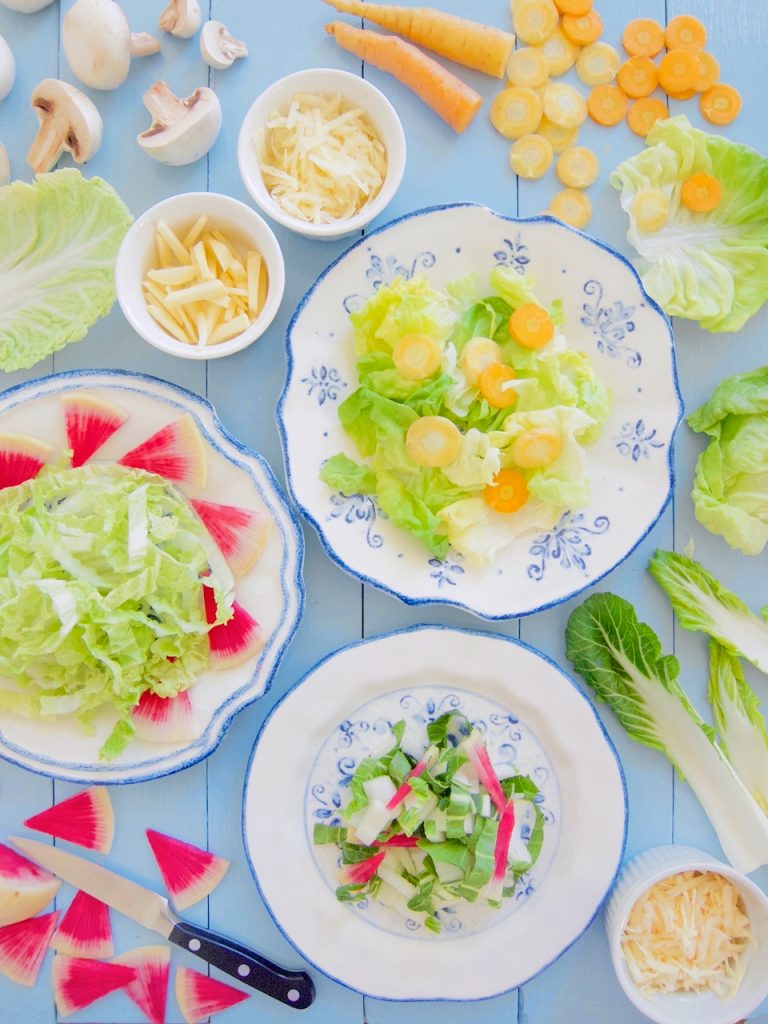
(Pictured: white button mushrooms, cut up golden ball turnip, grated white sweet potato, sliced carrots, watermelon radishes, grated parsnips, bok choi, butter lettuce and napa cabbage)
In summary, while the gut microbiome isn’t telling your body to lift your arm, breathe or when to fall asleep, the gut microbiome is often referred to as a “second brain” or “other brain” because it’s running everything behind how those metabolic operations are functioning. What you learn is that your environment and what you put in your mouth directly effect your gut microbiome making these things very important to what you want your life to be.
According to microbiologists and the new paradigm of medical doctors, really being healthy starts with the gut microbiome. Get rid of the pathogens and other things that don’t belong, keep the microbes in balance with the right foods, and keep their home un-inflamed by removing the problematic foods from your diet, take needed nutritional support, lower stress, avoid toxins, exercise and the human body has shown that it can self heal. Weight will come more into balance, and improvements will take place physically, intellectually, and you will feel better emotionally.
The difference with a healing of the gut, and balancing of the microbiome, centered diet and the healthy diets we thought we were on is small amounts of more kinds of foods and more variety of raw vegetables with a focus on roots and tubers, making it probiotic (if they aren’t soaked or washed too much) and prebiotic. To give you an idea of all the different vegetables out there in the world – like ambutan, limau, spapote — see specialtyproduce.com’s website. Check out farmers markets or specialty markets, preferably organic where you will find foods grown in the different soils of different organic farms. At Mom’s Organic Market, you can find produce that is like going to a good farmer’s market where you find more unusual produce and it’s not over washed and that has avoided cross contamination in a warehouse with vegetables treated with pesticides.
All the things you’ve heard before that are ‘good for you’ take on a new meaning as you study how the human body is returned to proper function. It’s not easy to fit all of them into our lives. If you can see how they can make a difference in your quality of life, giving them a try and adding a new health routine becomes easier. While you are feeding and caring for the various microbe crews doing their jobs in your powerhouse, you will notice so many more friendly foods and enjoy their rainbow of colors and tastes and you will become emotionally attached to them. You will see ‘variety is the spice of life’ in a new way.
Eating raw vegetables provides a small amount of probiotics, a lot of prebiotic fiber, enzymes that help with digestion, and vital nutrients. Cooked vegetables still have prebiotic fiber but in general lose some of their nutrition. There are exceptions where they have more nutrition and some taste better and some are easier to digest when they are cooked. The cooked version of a vegetable and the raw version are different foods to the microbes, adding to the variety of foods you’re feeding them.
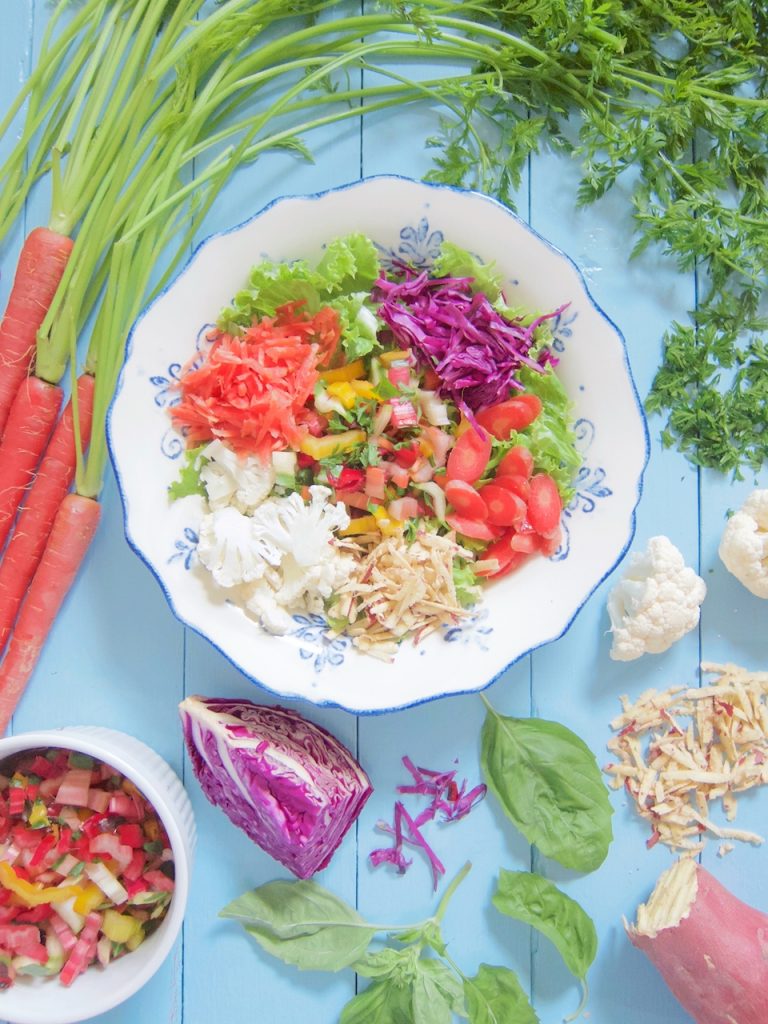
(Pictured: green leaf lettuce, carrot tops chopped fine, cauliflower sliced thin, carrots sliced and grated, red cabbage thinly sliced, grated Japanese sweet potato, fresh basil leaves, rolled together and sliced [chiffonade] and sliced rainbow swiss chard ribs.)
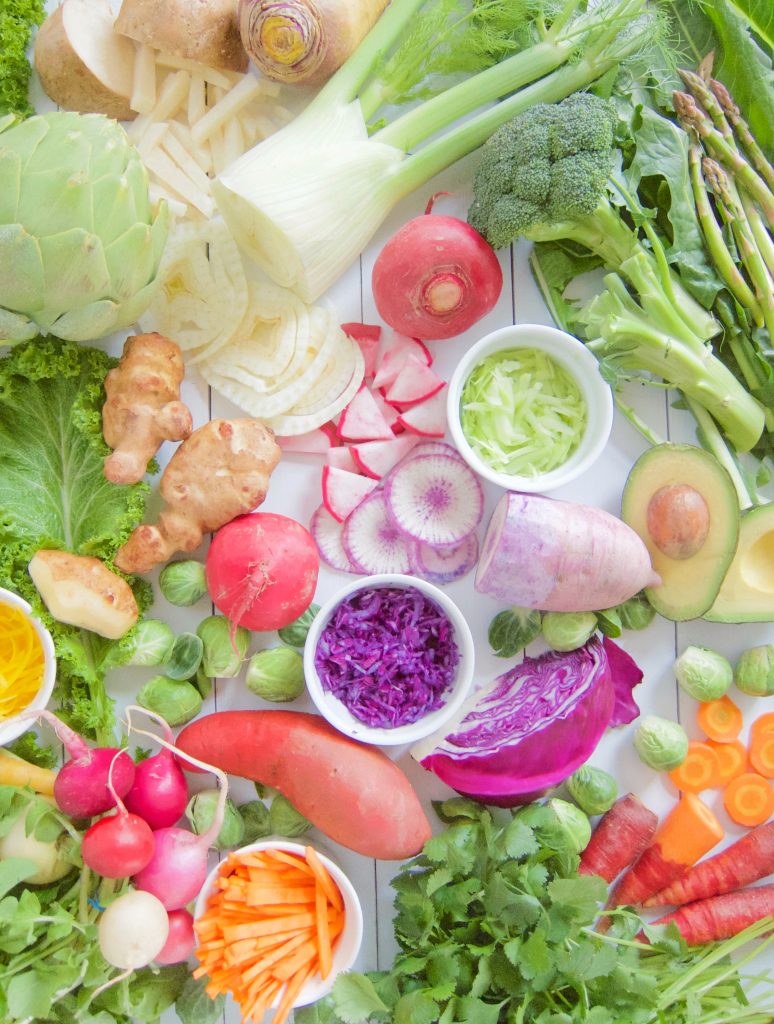
-
Pictured above:
- Artichoke is a little more exotic and you eat it differently than any other food. They are steamed 20 to 40 minutes depending on the size. Begin preparing them by cutting a 1/2 inch off the top and bottom. If you want to you can cut the sharp tips off the leaves with cooking scissors. Place them on the steam basket over the boiling water and cover. You can check for tenderness by grabbing one with tongs and turning it over and putting a fork in the heart. Another test people use is the leaves should remove easily. In time you’ll be able to tell just by the very olive color of a cooked artichoke. Transfer the artichoke to a large plate. Starting from the outside, the first rows of leaves are eaten by turning the leaf so the tender side is facing your lower teeth and pressing upper and lower teeth against the leaf as you slide it out, scraping the tender part off into your mouth. About half way through the artichoke, the entire bottom of the leaves will become tender and at one point you can start removing them in bunches by pinching the tops and pulling them off together, and then biting off the entire bottom. When you reach the end of the leaves, scoop off the inedible fuzz with a spoon, being careful not to remove part of the heart. You can dip everything in melted butter as you go.
- Jicama normally needs to have the outside skin cut off because it’s too stringy to chew. Jicama can be grated or cut into sticks and used like carrot sticks with a dip or put in salads or tossed into smoothies.
- Rutabaga can be cut into cubes and steamed or boiled and mashed. Or it can be grated and put in salads or sliced into small thin pieces and put in smoothies. Leave the peel on for more nutrition, fiber and the possibility of some microbes still being there.
- Fennel can be eaten root-to-stem. Slice the stems, delicate fronds, and bulb very thin and put this in salads.
- Broccoli’s flavor is improved by cooking. It’s delicious steamed. It can be used from root-to-stem by peeling the stems and cutting them into coins and adding these to the tops when steaming or slice the florets very thin and grate the rest and put these in salads. Add only a small amount to salads because broccoli is harder to digest and can cause bloating.
- Asparagus is okay to eat raw but its nutrients are better absorbed by the body when they are cooked. Snap off the bottom of the stem to remove the toughest part then bake, steam or lightly steam thinner ones, cool and add to salads.
- Dandelion greens are good in salads. Use from root-to-stem by slicing the stems in 1/4 inch pieces.
- Avocado is on the list of healthy oils. Cut in half and remove the pit and eat as is with a seasoning salt. Make a guacamole to dip vegetables in or cut up for salads. Great in sandwiches using lettuce for the ‘bread’.
- Brussel sprouts can be eaten raw, thinly sliced and added to salads. Steaming them improves their flavor and makes them easier to digest.
- Scarlet turnips is nice cubed and steamed with other vegetables like carrots. This sweet tender turnip can also be cut in bite-sized pieces or grated and put in salads and smoothies. Remove the tough parts but leave the more tender parts of the outer skin on for more nutrition, fiber aand the possibility of some microbes still being there.
- Red cabbage can be steamed or thinly sliced or grated and put in salads.
- Heirloom carrots can be thinly sliced or grated and put in salads and smoothies. Leave the peel on for more nutrition, fiber and and the possibility of some microbes still being there.
- Cilantro can be chopped and added to in salads.
- Sweet potato is great baked or boiled and mashed. It can be spiralized, or thinly sliced or grated for smoothies or salads. If eating raw, leave the skin on for more nutritional, fiber and the possibility of some microbes still being there.
- Radishes can be grated or sliced and put in salads.
- Mustard greens eaten raw have a bite to them that mellows when they are cooked. When cooking with them, think of them like spinach or kale and collard greens. They can be sautéed or steamed. Or tear in bite sized pieces and mix it with other lettuces like romaine for salad greens.
- Yellow carrots are good steamed. They can also be grated or thinly sliced or julienned and put in salads. Leave the peel on for more nutrition, fiber and possible microbial benefits.
- Sun chokes or Jerusalem artichokes are a little like potatoes. They can be eaten cooked. Or slice or grate and put in salads. If eating raw, leave the skin on, removing any chucks of dirt caught in crevices, for more nutrition, fiber and and the possibility of some microbes still being there.
- The purple root is a daikon radish. They are good thinly sliced and put in a salad. Leave the out skin on for more nutrition, fiber and and the possibility of some microbes still being there.
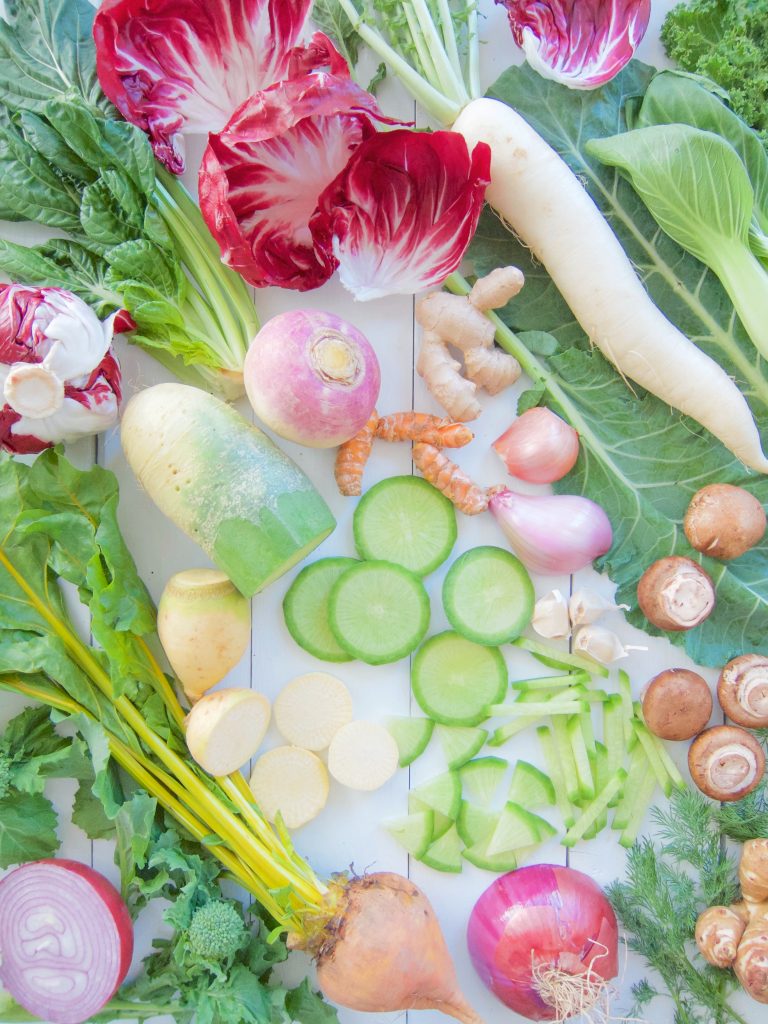
Pictured above:
- Tatsoi leaves can be used like spinach, good sliced and added to salads and smoothies.
- Radicchio can be torn into pieces and added to salads but it’s bitter so use a small amount.
“Radicchio (pronounced rah-DEE-kee-oh) is a flamboyant wine-colored member of the chicory family. It is related to Belgian endives and has a similar bitter, slightly spicy taste.”
precisionnutrition.com - White daikon radish is a sweet radish that is large enough to be cut like jicama and carrots and served with dips and is good added to relish trays and salads. Leave the out skin on for more nutrition, fiber and the possibility of some microbes still being there.
- Bok choy can be sliced and steamed or sliced thin and added to salads.
- Crimini mushrooms, along with white buttons, crimini, enokis and portabellas, are considered safe to be eaten raw, although there is still some debate over this.* Add to a relish tray with dips or cut up in a salads.
- Dill is good for flavoring foods like eggs, fish and chicken. It’s also a good flavoring for dips and salad dressing. Or you can just chop it and put it in a salad.
- Sun chokes or Jerusalem artichokes are a little like potatoes. They can be eaten cooked. Or slice or grate and put in salads. If eating raw, leave the outer skin on, removing any chucks of dirt caught in crevices, for more nutrition, fiber and the possibility of some microbes still being there..
- Shallots can be used like onions for flavoring meats and vegetables and salads.
- Fresh turmeric is bitter. Rather than grate it and get the bitter flavor all over everything, I slice it at an angle and set the pieces on the side of a salad and use it as a condiment like pickles. Very often a medical plant looks like the organ it can help. The turmeric root resembles a part of the intestines and it’s very good for the gut. Ginger does too.
- Ginger is flavoring that you use sparingly because it’s strong. It pairs well with garlic in Chinese sautés. Grated ginger adds a fun taste to salads. Try garlic and ginger in salad dressings.
- Purple top turnip is the most commonly seen turnip in stores. It’s often boiled or steamed and mashed. It can also be grated and added to a salad. Leave the outer skin on for more nutrition, fiber and the possibility of some microbes still being there.
- The sliced green vegetable is a green daikon radish also known as ‘green meat radish’, ‘lime radish’, ‘honeydew radish’, and ‘oharu radish’. It can be mildly bitter so slice thin or grate for salads. Leave the outer skin on for more nutrition, fiber and possible microbial benefits.
- Gold ball turnip is not so common. I find it in a specialty organic market here. It’s delicious cubed and steamed. Or you can slice it thin, julienned or grated it and put in salads. Leave the peel on for more nutrition, fiber and the possibility of some microbes still being there.
- Golden beets turn grey when cut up or grated for a salad. Eat right away or use in smoothies or steamed. If eating raw, leave the tender parts of the skin on and remove the tough parts of the skin for more nutrition, fiber and and the possibility of some microbes still being there.
- Beet greens (and stems) can be steams and they work great in smoothies.
- Broccolini rabe needs to be soaked in cold water to remove some of the bitterness and any dirt that might be caught in the stems and leaves. Use small amounts in salads because broccoli is more difficult to digest and can cause bloating.
- Red onion like all onions are used for flavor. They can be chopped small or sliced thin for salads and will add beauty to the salad.

Pictured above:
- Red kale is delicious steamed root-to-stem or sliced and use as salad greens. Kale is a little bitter so you may not want to use it in smoothies.
- Blueberries are good in salads and smoothies or just to snack on.
- Red beets are good cut in cubes and steamed along with their greens and stems, or sliced small or grated and put in salads and smoothies. Cut of the rough parts off and leave tender part of the outer skin on for more nutrition, fiber and the possibility of some microbes still being there.
- Beet greens are good in smoothies.
- Japanese yams are more spongy and tough raw that other sweet potatoes. They are best baked or boiled and mashed. Or you can slice thin and add a little to smoothies, leaving the skin on for more nutrition, fiber and the possibility of some microbes still being there.
- Purple stoke sweet potatoes or yams are good baked or grated for salads or smoothies. Leave the skin on for more nutrition, fiber and the possibility of some microbes still being there.
- Purple and orange carrots are good steamed or slice or grate and put in salads and smoothies. Leave the outer skin on for more nutrition, fiber and possible microbial benefits.
- Watermelon radish is good sliced thin or grated for salads. Leave the outer skin on for more nutrition, fiber and the possibility of some microbes still being there.
- Black radish can be cut small or grated and put in salads. Leave the black outer skin on for more nutrition, fiber and possible microbial benefits.
- Red collard leaves can be cut off the rib and into pieces and steamed. Slice the as well into small pieces and steamed. Or both can be added to smoothies because collards are mild like spinach.
- Gold ball turnips can be cut into 1/2″ pieces and steamed along with other root vegetables. Or slice them thin, julienne them or grate them and add to salads. Leave the peel on for more nutrition, fiber and the possibility of some microbes still being there.
- Curly parsley and Italian parsley (stronger parsley taste) can be chopped and sprinkled on foods or salads. Add the chopped leaves and stems to smoothies.
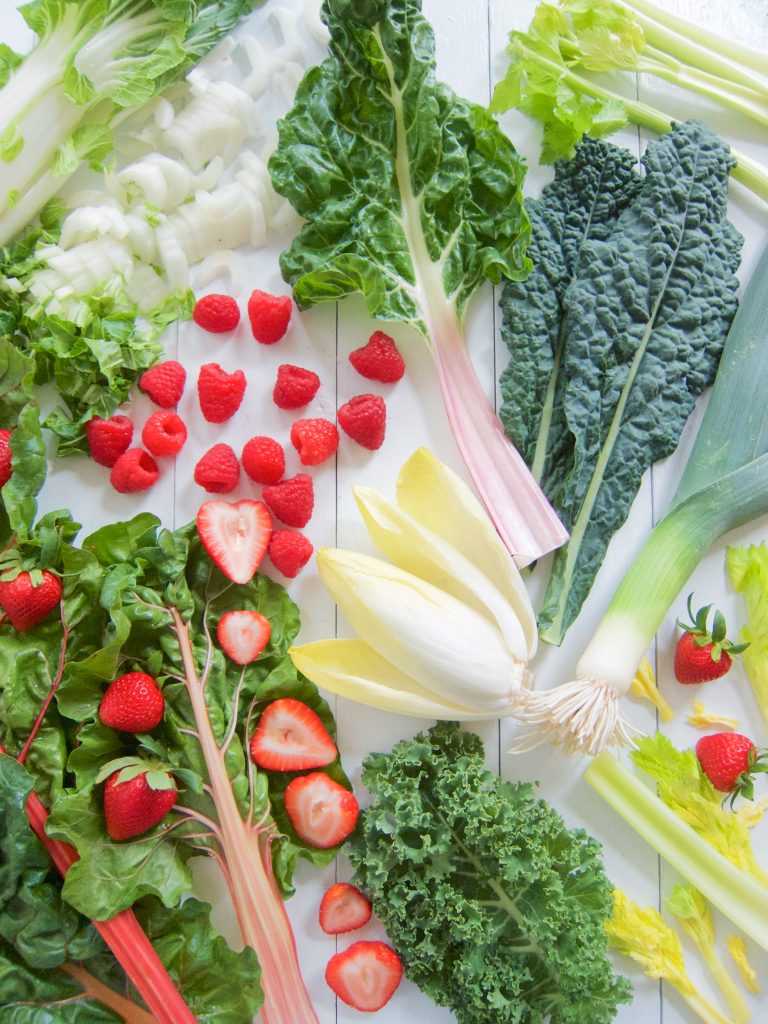
Pictured above:
- Large bok chop can be sliced, both stems and leaves, and steamed and is great for salad greens.
- Rainbow swiss chard is good steamed. Cut out the rib and slice it, then steam both the rib pieces and leaves. Because it’s mild like spinach it works in smoothies (add the rib pieces too).
- Lacinato or Tuscun kale is good sliced for salads.
- Leeks are used like onions and have a mild, wonderful flavor. Remove the dark green parts and save for soup stock. The white and light green parts can be sliced thin and added to salads.
- Celery can be cut in 3″ pieces like carrots and jicama and used in relish trays with dips. Or they can be chopped or sliced for salads and smoothies.
- The leaves and sliced stems of Kale can be steamed. They make good greens for a salad. Kale is a little bitter so you make only want to used a small amount in a smoothie
- Belgian endive is good on relish trays with dips and in salads.
- Strawberries are good in salads and smoothies or just to snack on.
- Raspberries are good in salads and smoothies or just to snack on.

Pictured above:
- Green cabbage can be steamed. Or slice it thin or grate it and use it alone or mixed with other greens for salads.
- White sweet potato is good baked or boiled and mashed. Or it can be grated and used in small amounts in salads and smoothies. Leave the skin on for more nutrition, fiber and the possibility of some microbes still being there.
- Romanesque is used like cauliflower. It can be steamed, then served hot or cold in a salad or sliced thin and added in small amounts to salads.
- Butter lettuce is a delicate salad green.
- Napa cabbage can be sliced and steamed. Or slice thin for salad greens.
- Parsnips are sweet like carrots and are good steamed with other vegetables, or sliced thin or grated and use in salads and smoothies. Leave the outer skin on for more nutrition, fiber and the possibility of some microbes still being there.
- Large watermelon radishes are good sliced thin or grated and use in salads. Leave the outer skin on for more nutrition, fiber and the possibility of some microbes still being there.
- White button mushrooms are good use in salads or on a relish tray with dips.
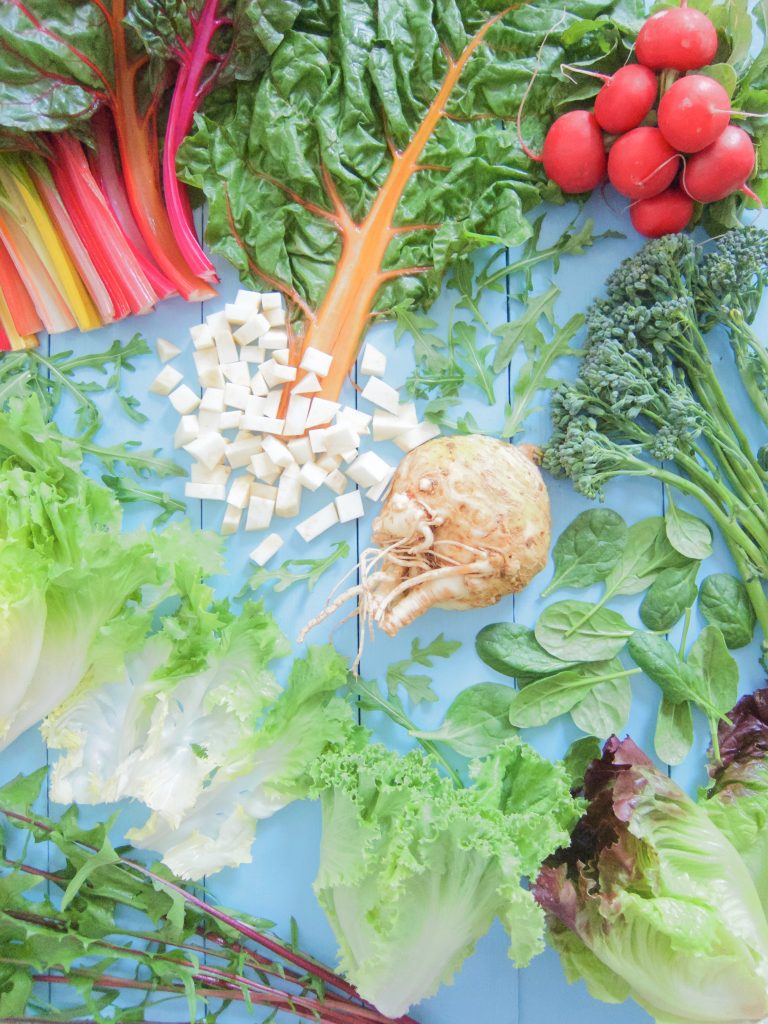
“Unless you’re composting you’re getting rid of essential veggie nutrition that could be beneficial to you. Vegetable stems including kale, collards, parsley and swiss chard are loaded with vitamins, fiber and nutrients because the stem is the component that is rooted in the soil.”
naturallysavvy.com
Pictured above:
-
>Red radishes are good cut in matchsticks or slices for salads.
- Baby broccoli is used like normal broccoli. It is good steamed or sliced and a small amount added to salads.
- Baby spinach is good steamed and used as salad greens.
- Red leaf lettuce is used for salad greens and can be the ‘bread’ for sandwiches.
- Green leaf lettuce is used for salad greens and can be the ‘bread’ for sandwiches.
- If red dandelion is tender, it’s good sliced along with the stems and put in salads.
- Escarole is used for salad greens.
- Baby arugula has a strong taste that is a little bitter. It can be used for salad greens.
- Celery root or celeriac has a thick outer skin that needs to be cut off. Then cut the root into 1/2 inch cubes, and steam or boil and mash.

Pictured above:
- Use Cilantro or “Chinese parsley” like parsley sprinkled on foods or in salads.
- Green onions also called scallions and spring onions are good sliced slice thin and sprinkle on foods or salads.
- Japanese Hakurei turnips or “salad turnips” are good steamed or used root-to-stem in salads. Leave the outer skin on for more nutrition, fiber and the possibility of some microbes still being there.
- Red kale stems can be cut into 1/4 inch pieces and steamed along with the leaves.
- Broccolini rabe unlike broccoli and baby broccolini, is a little bitter. Soaking broccolini rabe in cold water for a hour will remove some of the bitterness and any dirt that might be caught in the stems and leaves. They are good steamed, or cut small and add a little salads.
“If desired, you can cut the stems off the broccoli rabe up to the bottom of the leaf. Stems can be chopped and cooked a few minutes longer than the leaves. Stems of broccoli rabe can also be discarded and only the leaves and buds prepared and eaten.” Wikihow.com - Endive frisee is good for salad greens combined with other greens.
- Yellow onion
- White onion
- The diced root in the middle of the picture is a rutabaga. They can be steamed with carrots and mashed if desired. They can be grated and added to salads or cut small and put in smoothies. Remove any thought parts and leave the tender parts of outer skin on for more nutrition, fiber and the possibility of some microbes still being there.
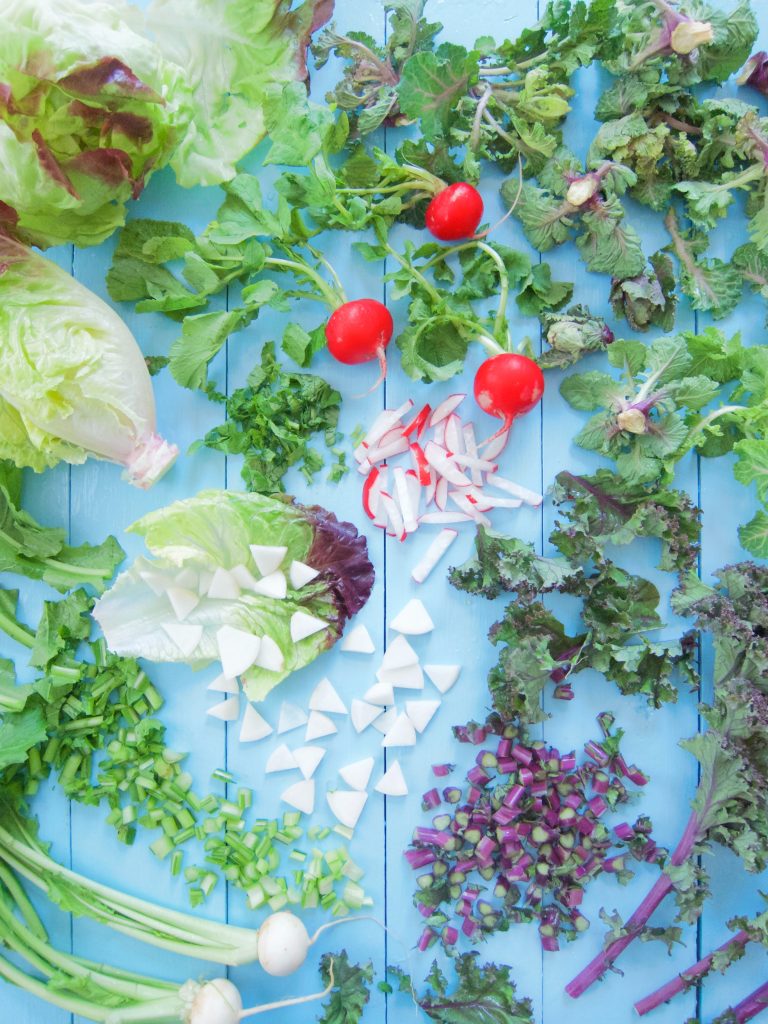
For years I’ve been unknowingly throwing away food because I had no idea the stems and leaves of many vegetables I’ve been cutting off and throwing away are not only edible but nutritious and delicious. Many vegetables can be eaten ‘root-to-stem’. Great chefs are a part of the ‘root-to-stem’ movement that has resulted in a whole new set of recipes that are very fun. The ribs and stems of vegetables are full of fiber and nutrition. Peels are another thing I’ve been throwing away and they are also full of nutrition. Cabbage cores can be grated for salads. I’m now only throwing away the part of vegetables that are tough. Try a piece and if you can’t chew it, then toss it or you can save parts of vegetables in the freezer to make a vegetable broth.
Pictured above:
- Red butter lettuce is a delicate salad green.
- Cut up red kale from root to stem and steam or cut small and use in salads.
- Cut up Hakurei turnips from root-to-stem and add a small amount to salads. Leave the outer skin on for more nutrition, fiber and and the possibility of some microbes still being there.
- Cut up radish from root-to-stem and add a small amount in salads.
- Kallettes are a cross between kale and Brussel sprouts. Steam them or cut them in small pieces for salads.



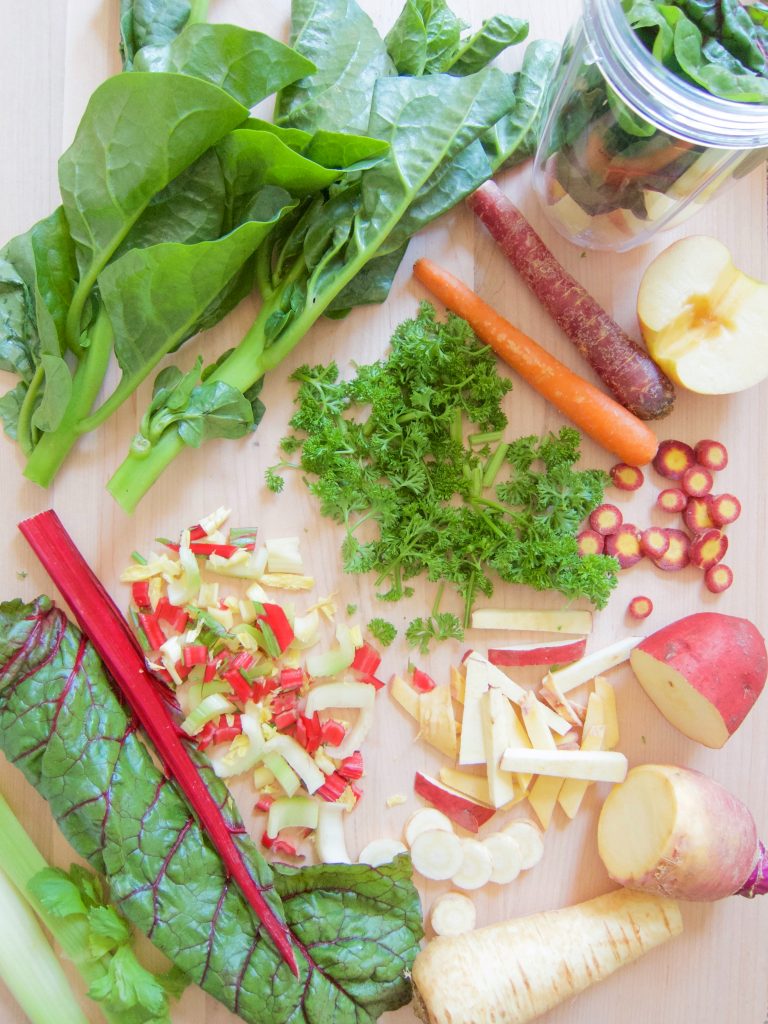
I’ve found that bitter vegetables can have and overpowering taste in a smoothie. I recommend using radish tops and turnips for the salad and choosing mostly sweet roots (like beets, jicama, parsnips, rutabaga, sweet potatoes, and carrots) and less bitter greens (like spinach, collards, swiss chard, and beet tops and celery tops) for smoothies. Pictured: spinach, collard greens and stems, apple (also like pears or Asian pears), parsnip, white carrot, sweet potato, golden beet, parsley, green algae powder, malabar spinach, red carrot, Japanese sweet potato, rutabaga, swiss chard, celery and water.
Adding unsweetened cacao nibs and whey protein powder or pea protein powder, if you can tolerate them (one is dairy and the other has lectins), are a delicious addition to smoothies and these protein isolates powders supply all eight amino acids for building the body.
Please note:
There’s a reason why you don’t see leaves on tomatoes at the store. They are poisonous. As you add new vegetables and fruits to your diet, keep in mind foods that some foods that are very nutritious but should not be eaten raw because they contain toxins that can make you very sick. Some of these toxins can be neutralized by proper preparation:
- Chaya, a shrub native to Mexico’s Yucatan peninsula, is called “tree spinach.” The nutrients in these leaves were found to be an herbal remedy of a number of health ailments. But the raw leaves have toxic compounds. They are cooked for 20 minutes and served with butter or oil. Dr. Weil says not to cook them in aluminum pans.
- Yucca or cassava root contains cyanide and must be dried, soaked in water, rinsed and cook soon after harvesting. Like chaya, the leaves have a high concentration of cyanide to ward off bugs.
- Taro root is a superfood, full of healthy nutrients, but in its raw state it’s toxic due to its calcium oxalate content.
- Both the leaves and roots of taro have to be cooked. Boil, steam or bake them like potatoes. Dr. Mercola’s Food Facts states that “This plant contains needle-like calcium oxalate crystals, which can lead to extreme irritation in your throat and mouth, resulting in a burning and stinging sensation. If consumed without cooking it thoroughly, it may also result in gout and kidney stones.”
- “A luscious looking olive, ripe off the sun-warmed tree, is horrible.
The substance that renders it essentially inedible is oleuropein, a phenolic compound bitter enough to shrivel your teeth. The bitterness is a protective mechanism for olives, useful for fending off invasive microorganisms and seed-crunching mammals.” National Geographic - *Raw wild mushrooms have all different kinds of toxins that are neutralized when cooked. The list is short for the mushrooms that are considered edible raw but people can still have a reaction to the small amount of toxins that can be in these. There debate continues on these so it appears that there is not a lot of concern about white, crimini, enokis and portabella.
- The lectins in beans are too strong in the raw state. They have to be cook and it’s best to do this using a pressure cooker.
- Bad bacteria can be growing on sprouted seeds that begins during the sprouting process itself. They are risky to eat raw.
- Non-sweet potatoes like russets, yukon gold, red, fingerlings have a strong toxin called solanine. There is more of this compound when they have started to turn green and sprout. Do not eat them raw.
- Yuca has traces of cyanide that needs to be cooked out. Do not eat them raw.
- Rice has arsenic but not enough to take it off the shelves. Arsenic-based pesticides were heavily used on crops for decades and new crops absorb the arsenic from the water and soil. Brown rice has the most. White basmati is the best choice. Soaking rice overnight draws arsenic out. Then rise it well.
- Even cooking rhubarb leaves does not get rid of its oxalic acid that is used to make bleach and anti-rust products. Do not eat rhubarb leaves.
- The seeds of apples, mangoes, peaches, pears and apricots have cyanide and like rhubarb leaves should not be eaten at all.
I’m including a link to a very good article about our body’s pH levels and cancer that straightens out the misunderstanding that we can effect the pH levels of our blood by what we eat. The reason people were buying the urine test strips and became interested in doing this were buying the urine test strips was because we were told that cancer cells thrive in an acidic environment and we thought what we ate determined the pH level of that environment. The truth is it’s not our diet that creates that environment. Our bodies keep our blood at the right pH balance. It’s the cancer itself that creates the acidic environment. But the right foods, feeding our guts the food they need, changes the inflammatory condition of our bodies discouraging growth of cancer cells.
curetoday.com
